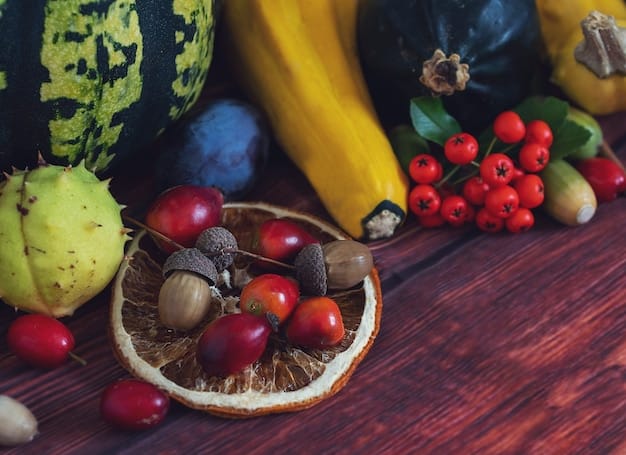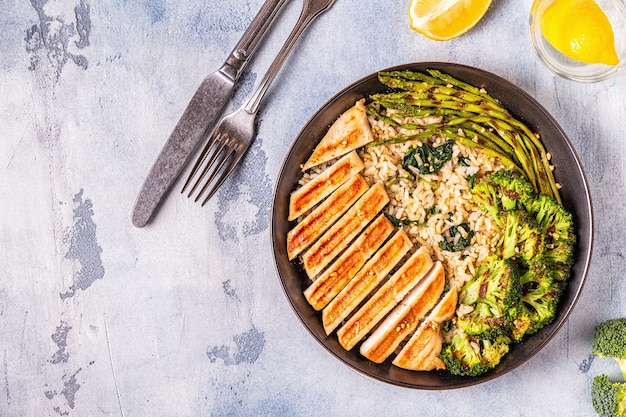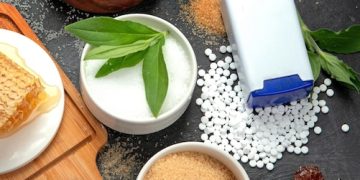Combat Inflammation with US Anti-Inflammatory Foods

Adopting an anti-inflammatory diet is a powerful strategy to mitigate chronic inflammation, a root cause of many prevalent health conditions in the US, by focusing on nutrient-dense, whole foods readily available in American markets.
Chronic inflammation, often an unseen adversary, silently erodes health, contributing to myriad modern ailments from heart disease to autoimmune disorders. But what if the solution lay in something as fundamental as our diet? Exploring how to Fight Inflammation with Food: Top Anti-Inflammatory Choices for US Diets offers a promising path to enhanced well-being.
Understanding Chronic Inflammation: The Unseen Health Threat
Chronic inflammation is not the same as acute inflammation, which is your body’s essential response to injury or infection. While acute inflammation is beneficial, chronic inflammation is a prolonged, low-grade immune response that can be detrimental. It’s often fueled by lifestyle factors, including dietary choices common in the US, and can persist for months or years, damaging healthy tissues and organs.
The ubiquity of processed foods, high sugar intake, and unhealthy fats in the typical American diet contributes significantly to this pervasive issue. Recognizing the signs and understanding the mechanisms of chronic inflammation are crucial first steps toward addressing it through nutrition. It’s a complex interplay between genetics, environment, and daily choices that dictates our inflammatory state.
The Silent Contributor to Disease
Many chronic diseases prevalent in the United States have a strong inflammatory component. This includes conditions such as type 2 diabetes, cardiovascular disease, certain cancers, and neurodegenerative disorders like Alzheimer’s. The continuous immune activation can lead to cellular damage and disrupt normal bodily functions, underpinning the need for proactive dietary interventions.
- Cardiovascular disease: Inflammation contributes to plaque buildup in arteries.
- Type 2 diabetes: Chronic inflammation can lead to insulin resistance.
- Autoimmune diseases: An overactive immune response targets healthy cells.
- Cancers: Inflammation can promote tumor growth and spread.
Addressing chronic inflammation through an informed diet can significantly reduce the risk and progression of these debilitating conditions, offering a pathway to improved long-term health and vitality. It’s about shifting from a pro-inflammatory eating pattern to one that actively dampens inflammatory pathways within the body.
The Power of Nutrition: How Food Fights Inflammation
Food isn’t just fuel; it’s a powerful messenger to our cells, influencing genetic expression and systemic processes, including inflammation. An anti-inflammatory diet emphasizes whole, unprocessed foods rich in antioxidants, omega-3 fatty acids, and fiber, while limiting ingredients known to promote inflammation. This dietary approach works by modulating immune responses and reducing oxidative stress.
The beneficial compounds in anti-inflammatory foods actively intervene in various stages of the inflammatory cascade. For example, potent antioxidants found in fruits and vegetables neutralize free radicals, which are compounds that can trigger cellular damage and inflammation. Dietary fiber supports a healthy gut microbiome, which in turn influences systemic inflammation.
Key Nutritional Components for Anti-Inflammation
Understanding which specific nutrients and compounds are beneficial helps in making informed food choices. This isn’t about restrictive eating but about embracing a broader spectrum of nutrient-dense ingredients that work synergistically to promote health.
- Antioxidants: Found in colorful fruits and vegetables, they combat oxidative stress.
- Omega-3 Fatty Acids: Prevalent in fatty fish, they produce anti-inflammatory signaling molecules.
- Phytochemicals: Plant compounds like polyphenols and flavonoids have protective effects.
- Fiber: Supports gut health, which is intrinsically linked to immune regulation.
By consistently incorporating these elements into daily meals, individuals can establish a dietary foundation that naturally steers the body away from inflammatory states. The cumulative effect of these nutritional choices can lead to measurable improvements in inflammatory markers and overall well-being.
Top Anti-Inflammatory Food Choices Readily Available in US Markets
Many of the most powerful anti-inflammatory foods are staples in American grocery stores, making this dietary shift practical and accessible. Focusing on these readily available ingredients can simplify meal planning and encourage consistent healthy eating habits. The goal is to build meals around whole, unprocessed foods.
Think about the perimeter of your grocery store where fresh produce, lean proteins, and dairy are typically found. These sections are often brimming with anti-inflammatory powerhouses. Incorporating a variety of these foods ensures a broad spectrum of beneficial nutrients.

Fruits and Vegetables: Nature’s Antioxidant Powerhouses
Berries, leafy greens, and cruciferous vegetables are abundant in antioxidants and other anti-inflammatory compounds. Their high fiber content also supports gut health, which is critical for immune function. Aim for a diverse array of colors on your plate to ensure a wide range of beneficial phytochemicals.
- Berries: Blueberries, strawberries, raspberries are packed with anthocyanins.
- Leafy Greens: Spinach, kale, collard greens offer vitamins, minerals, and antioxidants.
- Cruciferous Vegetables: Broccoli, cauliflower, Brussels sprouts contain sulforaphane, a powerful anti-inflammatory compound.
These plant-based foods form the cornerstone of any anti-inflammatory diet, providing essential nutrients without the pro-inflammatory additives often found in processed foods. Their versatility makes them easy to incorporate into breakfast, lunch, and dinner.
Healthy Fats: Omega-3s and Monounsaturated Fats
Not all fats are created equal. While many processed foods contain pro-inflammatory trans and saturated fats, certain healthy fats are crucial for managing inflammation. Omega-3 fatty acids are particularly effective, producing compounds that reduce inflammatory responses.
Sources like fatty fish, avocados, and olive oil should be regular components of your diet. These fats not only help dampen inflammation but also contribute to satiety and overall cardiovascular health. Opt for extra virgin olive oil for cooking and dressing to maximize its benefits.
- Fatty Fish: Salmon, mackerel, sardines are rich in EPA and DHA omega-3s.
- Avocados: A great source of monounsaturated fats and vitamin E.
- Olive Oil: Contains oleocanthal, which has anti-inflammatory properties similar to ibuprofen.
Including these fats in moderation can significantly improve your body’s ability to combat inflammation, providing essential fatty acids that are often lacking in the standard American diet. They are fundamental for cellular health and immune function.
Whole Grains and Legumes: Fiber and Nutrient Density
Opting for whole grains over refined grains provides a wealth of fiber, B vitamins, and minerals that support overall health and help regulate inflammation. Legumes, such as beans and lentils, are also excellent sources of fiber and plant-based protein.
The fiber in these foods promotes a healthy gut microbiome, which plays a pivotal role in modulating systemic inflammation. A diverse and robust gut flora can significantly contribute to a more balanced immune response, reducing the likelihood of chronic inflammatory states.
- Oats: A fantastic source of soluble fiber, which benefits gut health.
- Brown Rice: A whole grain alternative to white rice, providing more fiber and nutrients.
- Lentils and Beans: Rich in fiber, protein, and various minerals that support metabolic health.
Integrating these complex carbohydrates into your diet provides sustained energy and contributes to a healthy inflammatory profile. They are versatile ingredients that can be used in a variety of dishes, from stews to salads.
Herbs and Spices: The Flavorful Anti-Inflammatory Agents
Beyond their culinary appeal, many herbs and spices possess remarkable anti-inflammatory properties, making them valuable additions to any US diet. Turmeric, ginger, and garlic are particularly noteworthy for their potent bio-active compounds that actively combat inflammation.
These natural additions can elevate the flavor of your dishes while providing therapeutic benefits, offering a simple and delicious way to enhance your anti-inflammatory efforts. Incorporating them into daily cooking can significantly contribute to your overall health strategy.
Turmeric, Ginger, and Garlic: Culinary Medicines
Turmeric: Its active compound, curcumin, is renowned for its powerful anti-inflammatory effects. It can be added to curries, smoothies, or even warm milk. Ginger: Known for centuries in traditional medicine, ginger contains gingerols, which possess significant anti-inflammatory and antioxidant properties. It can be used in teas, stir-fries, or baked goods. Garlic: Beyond its distinct flavor, garlic contains sulfur compounds that have been shown to reduce inflammation and support immune function. It’s a versatile ingredient for nearly any savory dish.
- Turmeric: Potent curcuminoids block inflammatory pathways.
- Ginger: Gingerols and shogaols reduce pain and inflammation.
- Garlic: Sulfuric compounds modulate immune responses.
By regularly incorporating these flavorful medicinal spices into your cooking, you can enhance both the taste and the health benefits of your meals. They are easy to find in any US grocery store and offer a natural way to bolster your body’s defenses against inflammation.
Building an Anti-Inflammatory Meal Plan for US Diets
Translating knowledge of anti-inflammatory foods into practical daily meal plans is key for sustainable benefits. An effective meal plan doesn’t have to be rigid or complicated; it simply requires conscious choices and a focus on whole, nutrient-dense ingredients that align with common American eating habits.
Start by making small, incremental changes to your existing diet rather than attempting a complete overhaul. This approach is more sustainable and allows your palate and body to adjust gradually to new food patterns. Remember, consistency is more important than perfection.

Sample Day: Anti-Inflammatory Eating
A typical day might begin with oatmeal topped with berries and nuts for breakfast, providing fiber, antioxidants, and healthy fats. Lunch could be a large salad with a variety of leafy greens, colorful vegetables, chickpeas, and a lean protein like grilled chicken or salmon, dressed with olive oil and vinegar. Dinner might feature fatty fish, such as wild salmon, paired with roasted cruciferous vegetables and a serving of brown rice or quinoa. Snacks can include apples with almond butter or a handful of walnuts.
This structure provides a framework for integrating anti-inflammatory foods naturally throughout the day, ensuring a consistent intake of beneficial compounds. It demonstrates that delicious and satisfying meals can also be powerfully health-promoting.
- Breakfast: Oatmeal with berries, nuts, and a sprinkle of cinnamon.
- Lunch: Large mixed greens salad with lean protein (salmon/chicken), diverse vegetables, and avocado.
- Dinner: Baked salmon or lean turkey with roasted sweet potatoes and asparagus.
Meal prepping can be particularly helpful, allowing you to prepare healthy components in advance, reducing the temptation to reach for less nutritious options when short on time. Planning your meals around these principles makes fighting inflammation with food an achievable daily goal.
Beyond Food: Lifestyle Factors Supporting Anti-Inflammation
While diet plays a pivotal role, adopting an anti-inflammatory lifestyle extends beyond just what’s on your plate. Other factors like stress management, regular physical activity, and adequate sleep significantly influence the body’s inflammatory responses. These elements work synergistically with dietary changes to create a holistic approach to managing inflammation.
Ignoring these other aspects can undermine even the most diligent dietary efforts. For instance, chronic stress can trigger inflammatory pathways regardless of how optimally you eat. Therefore, a comprehensive strategy involves addressing all major lifestyle contributors to inflammation.
The Interconnectedness of Health
Stress Management: Chronic stress releases hormones like cortisol, which, over time, can promote inflammation. Practices like meditation, yoga, or spending time in nature can help mitigate stress. Regular Exercise: Moderate physical activity has been shown to reduce inflammatory markers and improve immune function. Aim for a mix of cardiovascular exercise and strength training. Quality Sleep: Lack of sleep can disrupt circadian rhythms and increase inflammatory cytokines. Prioritizing 7-9 hours of quality sleep per night is crucial for cellular repair and immune regulation.
- Stress: Chronic stress can elevate inflammatory markers.
- Exercise: Regular, moderate activity reduces systemic inflammation.
- Sleep: Adequate sleep is crucial for immune regulation and repair.
Integrating these lifestyle practices alongside an anti-inflammatory diet provides a robust defense against chronic inflammation, enhancing overall well-being and reducing the risk of disease. It’s about nurturing the body and mind in a holistic manner to create a resilient internal environment.
Navigating Challenges and Sustaining the Change
Adopting an anti-inflammatory diet in the US comes with its own set of challenges, from cultural eating habits to the omnipresence of pro-inflammatory processed foods. However, with strategic planning and a focus on sustainable changes, it’s entirely possible to integrate these principles into daily life. It’s not about perfection, but about consistent progress.
Educating oneself about ingredient labels, preparing meals at home, and seeking out healthy dining options when eating out are practical steps. The key is to view this transition as a journey toward better health rather than a restrictive diet with an end date.
Making It Work in Real Life
Meal Planning and Prepping: Dedicating time weekly to plan meals and prepare ingredients can significantly ease the burden of healthy eating during busy weekdays. Smart Grocery Shopping: Focus on whole foods. Shop the perimeter of the store and read labels carefully to avoid added sugars, unhealthy fats, and artificial ingredients. Dining Out Strategically: When eating out, look for options that prioritize fresh vegetables, lean proteins, and healthy fats. Don’t be afraid to ask for modifications, such as dressing on the side or grilled instead of fried.
- Meal Prep: Saves time and ensures healthy options are readily available.
- Grocery Choices: Prioritize fresh produce, whole grains, and lean proteins.
- Restaurant Awareness: Choose wisely, ask for adjustments when needed.
Building a supportive environment, whether through family involvement or a community of like-minded individuals, can also reinforce positive habits. Remember, every small step towards an anti-inflammatory diet contributes to a healthier you, making the long-term benefits well worth the effort.
| Key Point | Brief Description |
|---|---|
| 🍎 US Anti-inflammatory Foods | Focus on readily available foods like berries, leafy greens, salmon, and oats to combat inflammation. |
| 🌿 Herbal Allies | Incorporate turmeric, ginger, and garlic for their potent anti-inflammatory compounds. |
| 💪 Holistic Approach | Combine diet with stress management, exercise, and quality sleep for comprehensive anti-inflammatory benefits. |
| 🛒 Practical Application | Embrace meal planning, smart grocery shopping, and strategic dining out to sustain healthy habits. |
Frequently Asked Questions About Anti-Inflammatory Diets
▼
Chronic inflammation is a prolonged, low-grade immune response that damages healthy tissues. Unlike acute inflammation (which heals injuries), chronic inflammation can silently contribute to serious conditions like heart disease, diabetes, and autoimmune disorders. Addressing it with diet helps prevent and manage these long-term health issues.
▼
Top choices readily available in the US include berries (blueberries, strawberries), leafy greens (spinach, kale), fatty fish (salmon, mackerel), whole grains (oats, brown rice), and healthy fats (avocado, olive oil). Spices like turmeric and ginger also provide powerful anti-inflammatory benefits.
▼
Yes, limit or avoid processed foods, sugary drinks, refined carbohydrates (white bread, pasta), unhealthy fats (trans fats, excessive saturated fats found in fast food and highly processed snacks), and excessive alcohol. These items often promote inflammation in the body and can counteract healthy efforts.
▼
The timeline varies by individual, but many people report feeling better within a few weeks to a few months of consistently following an anti-inflammatory diet. Measurable improvements in inflammatory markers may take longer. Consistency is key, and benefits increase over time with sustained dietary habits and lifestyle changes.
▼
While not its primary goal, an anti-inflammatory diet often aids in weight management. It emphasizes whole, nutrient-dense foods high in fiber and healthy fats, which promote satiety and balanced blood sugar, naturally leading to reduced calorie intake. This can support healthy weight loss without strict calorie counting.
Conclusion
Embracing an anti-inflammatory diet is more than just a passing trend; it’s a profound shift towards a lifestyle that actively nurtures your body’s innate ability to heal and thrive. By prioritizing whole, unprocessed foods rich in antioxidants, healthy fats, and fiber – many of which are conveniently found in US markets – you can significantly mitigate the pervasive threat of chronic inflammation. This proactive approach to nutrition, combined with mindful lifestyle choices, offers a powerful pathway to enhanced well-being, energy, and a considerably reduced risk of chronic diseases. It’s an investment in your future health, one meal at a time.





